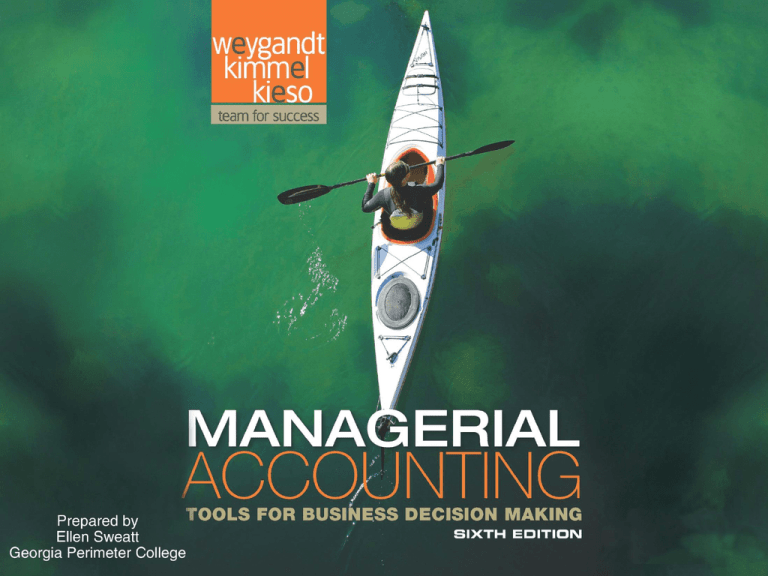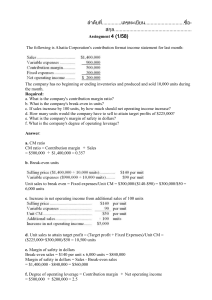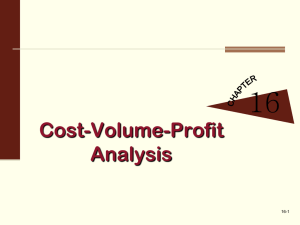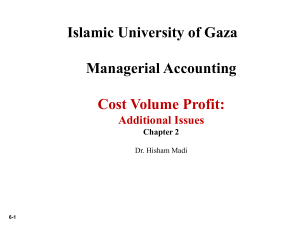
Chapter
6-1
6
Cost-Volume-Profit
Analysis:
Additional Issues
Chapter
6-2
Managerial Accounting, Sixth Edition
Learning Objectives
1.
Describe the essential
features of a cost-volumeprofit income statement.
2. Apply basic CVP concepts.
3. Explain the term sales mix
and its effects on break-even
sales.
4. Determine sales mix when a
company has limited
resources.
5. Understand how operating
leverage affects profitability.
Chapter
6-3
Chapter
6-4
Preview of Chapter
The relationship between a company’s fixed and
variable costs can have a huge impact on its
profitability.
The current trend is toward companies with cost
structures dominated by fixed costs.
This has significantly increased the
volatility of many companies’ net income.
Thus, the use of CVP analysis has additional uses in
making sound business decisions.
Chapter
6-5
Cost-Volume-Profit (CVP) Review
As noted in the previous chapter, CVP analysis is:
the study of the effects of changes in costs
and volume on a company’s profit.
CVP analysis is important to profit planning.
CVP analysis is critical in management decisions such
as:
determining product mix,
maximizing use of production facilities,
setting selling prices.
Chapter
6-6
Basic Concepts
CVP is so important, management often wants the
information reported in a special format income
statement.
The CVP income statement is for internal use only,
classifies costs and expenses as fixed or variable,
reports a contribution margin in the body of the
statement.
Contribution margin – amount of revenue
remaining after deducting all variable costs.
The contribution margin is often reported as a total
amount and on a per unit basis.
Chapter
6-7
LO 1: Describe the essential features of
a cost-volume-profit income statement.
BASIC CVP Income Statement –
Illustration 6-1
Chapter
6-8
LO 1: Describe the essential features of
a cost-volume-profit income statement.
CVP Income Statement - Example
The CVP income statement for Vargo Video Company is
illustrated below: (This illustration was also presented
in chapter 5.)
Illustration 6-2
Chapter
6-9
LO 1: Describe the essential features of
a cost-volume-profit income statement.
Basic Computations – A Review
Break-Even Analysis
As noted in Chapter 5, Vargo Video’s contribution
margin per unit is $200 (sales price $500 - $300
variable costs).
It was also shown that Vargo Video’s contribution
margin ratio was:
Chapter
6-10
LO 2: Apply basic CVP concepts.
Basic Computations – A Review
Break-Even Analysis
Vargo Video’s break-even point in units or in dollars (using
contribution margin ratio) is:
Illustration 6-4
In its early stages of operation, a company’s primary
goal is to break-even.
Failure to break-even will eventually lead
to financial failure.
Chapter
6-11
LO 2: Apply basic CVP concepts.
Basic Computations – A Review
Target Net Income
Once a company achieves break-even sales, a sales
goal can be set that will result in a target net income.
Assuming Vargo’s target net income is $250,000,
required sales in units and dollars to achieve this are:
Illustration 6-5
Illustration 6-6
Chapter
6-12
LO 2: Apply basic CVP concepts.
Basic Computations – A Review
Margin of Safety
Remember from Chapter 5, the margin of safety tells
us how far sales can drop before the company will
operate at a loss.
The margin of safety can be expressed in dollars or
as a ratio.
Assuming Vargo’s sales are $800,000:
Illustration 6-7
Illustration 6-8
Chapter
6-13
LO 2: Apply basic CVP concepts.
Basic Computations – A Review
CVP and Changes in the Business Environment
To better understand CVP analysis, three
independent cases involving Vargo will be examined.
Each case will use the original data for Vargo Video:
Basic Data:
Illustration 6-9
Chapter
6-14
LO 2: Apply CVP concepts.
Basic Computations – A Review: Case I
Illustration 6-9
Should Vargo Video match a competitor’s 10% discount
and reduce selling price to $450 per unit?
News Sales Price [$500 - (.10 × $500)] = $450.
New Contribution Margin ($450 - $300) = $150.
Illustration 6-10
Chapter
6-15
LO 2: Apply basic CVP concepts.
Basic Computations – A Review: Case I
Illustration 6-9
Should Vargo Video match a competitor’s 10% discount
and reduce selling price to $450 per unit?
Management must decide how likely it is that Vargo
can achieve the increase in sales as well as the
likelihood of lost sales if the discount is not matched.
Chapter
6-16
LO 2: Apply basic CVP concepts.
Basic Computations – A Review: Case II
Illustration 6-9
Use of new equipment is being considered that will
increase fixed costs by 30% and lower variable costs
by 30%. What effect will the new equipment have on
the sales required to break-even?
Fixed costs will increase $60,000 and variable costs
will decrease $90,000 (variable cost per unit = $210).
Chapter
6-17
LO 2: Apply basic CVP concepts.
Basic Computations – A Review: Case II
Illustration 6-9
Fixed costs will increase $60,000 and variable costs
will decrease $90,000 (variable cost per unit = $210).
The change appears positive as break-even point is
reduced by approximately 10%.
Illustration 6-11
Chapter
6-18
LO 2: Apply basic CVP concepts.
Basic Computations – A Review: Case III
Illustration 6-9
Vargo’s supplier of raw materials has increased the
cost of raw materials which will increase the variable
cost per unit by $25 to $325.
The selling price will remain the same at $500.
New contribution margin $175 ($500 - $325).
Management intends to cut fixed costs by $17,500 to
$ 182,500.
Chapter
6-19
LO 2: Apply basic CVP concepts.
Basic Computations – A Review: Case III
Illustration 6-9
Vargo currently has a net income of $80,000 on sales
of 1,400 DVDs.
How many more units will need to be sold to maintain
the $80,000 net income?
Chapter
6-20
LO 2: Apply basic CVP concepts.
Basic Computations – A Review: Case III
Variable cost per unit increases to $325 as a result of
the $25 increase in raw materials cost.
Fixed costs decrease to $182,500.
Contribution margin per unit is now $175.
Illustration 6-12
If Vargo cannot sell an additional 100 units,
management must further reduce costs, increase the
selling price of the DVDs, or accept a lower net income.
Chapter
6-21
LO 2: Apply basic CVP concepts.
Let’s Review
Croc Catchers calculates its contribution
margin to be less than zero. Which
statement is true?
a.
Its fixed costs are less than the variable
cost per unit.
b. Its profits are greater than its total
costs.
c.
The company should sell more units.
d. Its selling price is less than its variable
costs.
LO 1: Describe the essential
features of
a cost-volume-profit income statement.
Chapter
6-22
LO 2: Apply basic CVP concepts.
Sales Mix
When a company sells more than one product:
It is important to understand
its sales mix.
The sales mix is the relative percentage in
which a company sells its products.
If a company’s unit sales are 80%
printers and 20% computers, its
sales mix is 80% to 20%.
Sales mix is important because
different products often have very
different contribution margins.
Chapter
6-23
LO 3: Explain the term sales mix and its effects on break-even sales.
Break-Even Sales in Units
A company can compute break-even sales
for a mix of two or more products by
determining the:
Weighted-average unit contribution
margin of all products.
The weighted-average unit contribution
margin is the sum of the weighted
contribution margin of each product.
Chapter
6-24
LO 3: Explain the term sales mix and its effects on break-even sales.
Break-Even Sales in Units - Example
Assume that Vargo Video sells two products and has the
following sales mix and related information:
Illustration 6-13
Illustration 6-14
Chapter
6-25
LO 3: Explain the term sales mix and its effects on break-even sales.
Break-Even Sales in Units - Example
First, determine the weighted-average contribution
margin for Vargo’s two products:
Illustration 6-15
Second, use the weighted-average unit contribution
margin to compute the break-even point in units:
Illustration 6-16
Chapter
6-26
LO 3: Explain the term sales mix and its effects on break-even sales.
Break-Even Sales in Units - Example
With a break-even point of 1,000 units, Vargo must
sell:
750 DVD Players (1,000 units × 75%)
250 TVs (1,000 units × 25%)
At this level, the total contribution margin will equal
the fixed costs of $275,000 .
Illustration 6-17
Chapter
6-27
LO 3: Explain the term sales mix and its effects on break-even sales.
Break-Even Sales in Dollars
The calculation of break-even point in units works
well if the company has only a few products.
Consider 3M which has over 30,000 different
products:
3M would need to calculate 30,000 different
unit contribution margins.
When there are many products, calculate the breakeven point in terms of sales dollars for divisions or
product lines, NOT individual products.
Chapter
6-28
LO 3: Explain the term sales mix and its effects on break-even sales.
Break-Even Sales in Dollars - Example
Assume that Kale Garden Supply Company has two
divisions: Indoor Plants and Outdoor Plants.
Each division has hundreds of different plant
types.
Compute sales mix as a percentage of total dollar
sales rather than units sold,
and
Compute the contribution margin ratio rather than
the contribution margin per unit.
Chapter
6-29
LO 3: Explain the term sales mix and its effects on break-even sales.
Break-Even Sales in Dollars - Example
The information necessary to perform costvolume-profit analysis is:
Illustration 6-18
Illustration 6-19
Chapter
6-30
LO 3: Explain the term sales mix and its effects on break-even sales.
Break-Even Sales in Dollars - Example
First, determine the weighted-average contribution
margin ratio for each division:
Illustration 6-20
Second, use the weighted-average unit contribution
margin ratio to compute the break-even point in
dollars:
Chapter
6-31
Illustration 6-21
LO 3: Explain the term sales mix and its effects on break-even sales.
Break-Even Sales in Dollars - Example
With break-even sales of $937,500 and a sales mix
of 20% to 80%, Kale must sell:
$187,500 from the Indoor Plant division.
$750,000 from the Outdoor Plant division.
If the sales mix between the divisions changes, the
weighted-average contribution margin ratio also
changes, resulting in a new break-even point in
dollars.
Example - If the sales mix becomes 50% to 50%, the
weighted average contribution margin ratio changes
to 35%, resulting in a lower break-even point of
$857,143.
Chapter
6-32
LO 3: Explain the term sales mix and its effects on break-even sales.
Let’s Review
Net income will be:
a.
Greater if more higher-contribution margin units
are sold than lower-contribution margin units.
b. Greater if more lower-contribution margin units
are sold than higher-contribution margin units.
c.
Equal as long as total sales remain equal,
regardless of which products are sold.
d. Unaffected by changes in the mix of products
sold.
Chapter
6-33
LO 3: Explain the term sales mix and its effects on break-even sales.
Sales Mix with Limited Resources
All companies have limited resources whether it be
floor space, raw materials, direct labor hours, etc.
Limited resources force management to decide which
products to sell to maximize net income.
Example: Vargo makes DVD players and TVs. The
limiting resource is machine capacity – 3,600 hours per
month. Relevant date is as follows:
Illustration 6-22
Chapter
6-34
LO 4: Determine sales mix when a company has limited resources.
Sales Mix with Limited Resources - Example
The TVs seem to be more profitable since they have the
higher contribution margin per unit, but they require
more machine hours to produce than the DVD Players.
To determine the appropriate sales mix, compute the
contribution margin per unit of limited resource:
Illustration 6-23
Since DVD players have higher contribution margin per
machine hour, management should produce more DVD
players if demand exists or else increase machine
capacity.
Chapter
6-35
LO 4: Determine sales mix when a company has limited resources.
Sales Mix with Limited Resources - Example
Alternative: Increase machine capacity from
3,600 to 4,200 hours.
Illustration 6-24
To maximize net income, all 600 hours should be
used to produce and sell DVD players.
Chapter
6-36
Theory of Constraints
Approach used to identify and
manage constraints so as to
achieve company goals.
Requires identification of
constraints.
Continual attempts to reduce or
eliminate constraints.
Chapter
6-37
LO 4: Determine sales mix when a company has limited resources.
Let’s Review
If the contribution margin per unit is $15 and it takes
3.0 machine hours to produce the unit, the contribution
margin per unit of limited resource is:
a.
$25.
b. $5.
c.
$4.
d. No correct answer is given.
$15 ÷ 3 hours = $5 an hour
Chapter
6-38
LO 4: Determine the sales mix when a company has limited resources.
Cost Structure and Operating Leverage
Cost Structure is the
relative proportion of fixed
versus variable costs that a
company incurs.
May have a significant
effect on profitability.
Thus, a company must
carefully choose its cost
structure.
Chapter
6-39
LO 5: Understand how operating leverage affects profitability.
Comparison of Cost Structures
Vargo Video manufactures DVD players using a traditional,
labor-intensive manufacturing process.
New Wave Company also manufactures DVD players, but uses a
completely automated system where factory employees only set
up, adjust, and maintain the machinery.
Illustration 6-25
Both companies have the same sales and net income; however,
each has different risks and rewards due to changes in sales as
a result of their cost structures.
Chapter
6-40
LO 5: Understand how operating leverage affects profitability.
Effect on Contribution Margin Ratio
The contribution margin ratio for each company is as follows:
Illustration 6-26
Thus, New Wave contributes 80 cents to net income for each
dollar of increased sales while Vargo only contributes 40 cents.
However, New Wave loses 80 cents per dollar of sales
decrease while Vargo only loses 40 cents.
New Wave’s cost structure which relies on fixed costs is more
sensitive to changes in sales.
Chapter
6-41
LO 5: Understand how operating leverage affects profitability.
Effect on Break-even Point
The break-even point for each company is as follows:
Illustration 6-27
New Wave needs to generate $150,000 more in sales than
Vargo to break-even.
Because of the greater break-even sales required, New Wave is
a riskier company than Vargo.
Chapter
6-42
LO 5: Understand how operating leverage affects profitability.
Effect on Margin of Safety Ratio
The margin of safety ratio of each company is as follows:
Illustration 6-28
The difference in the margin of safety ratio reflects the
difference in risk between New Wave and Vargo.
Vargo can sustain a 38% decline in sales before operating at a
loss versus only a 19% decline for New Wave before it would be
operating “in the red.”
Chapter
6-43
LO 5: Understand how operating leverage affects profitability.
Operating Leverage
Operating leverage refers to the extent that net
income reacts to a given change in sales.
Higher fixed costs relative to variable costs cause
a company to have higher operating leverage.
When sales revenues are increasing, high operating
leverage means that profits will increase rapidly – a
good thing.
When sales revenues are declining, too much
operating leverage can have devastating
consequences.
Chapter
6-44
LO 5: Understand how operating leverage affects profitability.
Operating Leverage
The degree of operating leverage provides a measure
of a company’s earnings volatility.
The degree of operating leverage is computed by
dividing total contribution margin by net income.
The computations for Vargo and New Wave are:
Illustration 6-29
New Wave’s earnings would go up (or down) by about
two times (5.33 ÷ 2.67 = 1.99) as much as Vargo’s
with an equal increase in sales.
Chapter
6-45
LO 5: Understand how operating leverage affects profitability.
Chapter Review - Brief Exercise 6-9
Peine Candle Supply makes candles. The sales mix (as
a percent of total dollar sales) of its three product
lines is as follows: birthday candles, 30%; standard
tapered candles, 50%; and large scented candles,
20%. The contribution margin ratio of each candle
type is shown below.
Candle Type
Contribution Margin Ratio
Birthday
10%
Standard tapered
20%
Large scented
45%
What is the weighted-average contribution margin
ratio?
Chapter
6-46
Chapter Review - Brief Exercise 6-9
Type of Candles
CMR
Sales Mix
Birthday
10% ×
30%
=
Standard tapered
20%
×
50%
=
Large scented
45%
×
20%
=
Weighted Average Contribution Margin Ratio
3%
10%
9%
22%
If the company’s fixed costs are $440,000 per year, what is the
dollar amount of each type of candle that must be sold to break
even?
Step 1: Fixed Costs:
$440,000 ÷ WACMR 22% = $ BEP = $2,000,000
Step 2:
Birthday candles
Standard tapered
Large scented
Chapter
6-47
$2,000,000
$2,000,000
$2,000,000
×
×
×
30% = $ 600,000
50% =
1,000,000
20% =
400,000
$2,000,000
Appendix
Absorption Costing vs. Variable Costing
Under variable costing, product costs consist of:
Direct Materials
Direct Labor
Variable Mfg. Overhead
The difference between absorption and variable
costing is:
Illustration 16A-1
Chapter
6-48
LO 6: Explain the difference between absorption costing
and variable costing.
Appendix
Absorption Costing vs. Variable Costing
Under both costing methods,
selling and administrative
expenses are treated as period
costs.
Companies may not use variable
costing for external financial
reports because GAAP requires
that fixed manufacturing
overhead be treated as a
product cost.
Chapter
6-49
Fixed Mfg.
Overhead
LO 6: Explain the difference between absorption costing
and variable costing.
Appendix
Absorption Costing vs. Variable Costing
Example – Premium Products
Manufactures Fix-it, a sealant for car windows.
Relevant data for January 2012, the first month
of production are:
Illustration 6A-2
Chapter
6-50
LO 6: Explain the difference between absorption costing
and variable costing.
Appendix
Absorption Costing vs. Variable Costing
Example – Continued
Per unit manufacturing cost under each approach.
Illustration 6A-3
The manufacturing cost per unit is $4 ($13 - $9)
higher for absorption costing because fixed
manufacturing costs are treated as product costs.
Chapter
6-51
LO 6: Explain the difference between absorption costing
and variable costing.
Appendix
Absorption Costing Income Statement
Chapter
6-52
Illustration 6A-4
LO 6: Explain the difference between absorption costing
and variable costing.
Appendix
Variable Costing Income Statement
Chapter
6-53
Illustration 6A-5
LO 6: Explain the difference between absorption costing
and variable costing.
Appendix
Summary of Income Effects
Illustration 6A-14
Chapter
6-54
LO 7: Discuss net income effects under absorption costing
versus variable costing.
Let’s Review
Fixed manufacturing overhead costs are recognized as:
a.
Period costs under absorption costing.
b. Product costs under absorption costing.
c.
Product costs under variable costing.
d. Part of ending inventory costs under both
absorption and variable costing.
Chapter
6-55
LO 6: Explain the difference between absorption costing
and variable costing.
Copyright
Copyright © 2012 John Wiley & Sons, Inc. All rights reserved.
Reproduction or translation of this work beyond that permitted
in Section 117 of the 1976 United States Copyright Act without
the express written permission of the copyright owner is
unlawful. Request for further information should be addressed
to the Permissions Department, John Wiley & Sons, Inc. The
purchaser may make back-up copies for his/her own use only
and not for distribution or resale. The Publisher assumes no
responsibility for errors, omissions, or damages, caused by the
use of these programs or from the use of the information
contained herein.
Chapter
6-56








